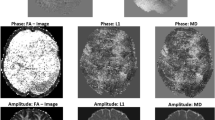Abstract
Diffusion MRI uses a multi-step data processing pipeline. With certain steps being prone to instabilities, the pipeline relies on considerable amounts of partly redundant input data, which requires long acquisition time. This leads to high scan costs and makes advanced diffusion models such as diffusion kurtosis imaging (DKI) and neurite orientation dispersion and density imaging (NODDI) inapplicable for children and adults who are uncooperative, uncomfortable or unwell. We demonstrate how deep learning, a group of algorithms in the field of artificial neural networks, can be applied to reduce diffusion MRI data processing to a single optimized step. This method allows obtaining scalar measures from advanced models at twelve-fold reduced scan time and detecting abnormalities without using diffusion models.
Chapter PDF
Similar content being viewed by others
Keywords
These keywords were added by machine and not by the authors. This process is experimental and the keywords may be updated as the learning algorithm improves.
References
Jensen, J.H., Helpern, J.A., Ramani, A., Lu, H., Kaczynski, K.: Diffusional kurtosis imaging: the quantification of non-Gaussian water diffusion by means of magnetic resonance imaging. Magnetic Resonance in Medicine 53(6), 1432–1440 (2005)
Zhang, H., Schneider, T., Wheeler-Kingshott, C.A., Alexander, D.C.: NODDI: practical in vivo neurite orientation dispersion and density imaging of the human brain. NeuroImage 61(4), 1000–1016 (2012)
Veraart, J., Sijbers, J., Sunaert, S., Leemans, A., Jeurissen, B.: Weighted linear least squares estimation of diffusion MRI parameters: strengths, limitations, and pitfalls. NeuroImage 81, 335–346 (2013)
Nilsson, M., Alerstam, E., Wirestam, R., Ståhlberg, F., Brockstedt, S., Lätt, J.: Evaluating the accuracy and precision of a two-compartment Kärger model using Monte Carlo simulations. Journal of Magnetic Resonance 206, 59–67 (2010)
Nedjati-Gilani, G., Hall, M.G., Wheeler-Kingshott, C.A.M., Alexander, D.C.: Learning microstructure parameters from diffusion-weighted MRI using random forests. Joint Annual Meeting ISMRM-ESMRMB, 2626 (2014)
Jarrett, K., Kavukcuoglu, K., Ranzato, M.A., LeCun, Y.: What is the best multi-stage architecture for object recognition? In: IEEE 12th International Conference on Computer Vision, pp. 2146–2153 (2009)
Vincent, P., Larochelle, H., Lajoie, I., Bengio, Y., Manzagol, P.A.: Stacked denoising autoencoders: learning useful representations in a deep network with a local denoising criterion. Journal of Machine Learning Research 11, 3371–3408 (2010)
Hinton, G.E., Srivastava, N., Krizhevsky, A., Sutskever, I., Salakhutdinov, R.R.: Improving neural networks by preventing co-adaptation of feature detectors. arXiv:1207.0580 (2012)
Saxe, A.M., McClelland, J.L., Ganguli, S.: Exact solutions to the nonlinear dynamics of learning in deep linear neural networks. In: International Conference on Learning Representations, Banff, Canada (2014)
Schultz, T.: Learning a reliable estimate of the number of fiber directions in diffusion MRI. In: Ayache, N., Delingette, H., Golland, P., Mori, K. (eds.) MICCAI 2012, Part III. LNCS, vol. 7512, pp. 493–500. Springer, Heidelberg (2012)
Nedjati-Gilani, G.L., Schneider, T., Hall, M.G., Wheeler-Kingshott, C.A.M., Alexander, D.C.: Machine learning based compartment models with permeability for white matter microstructure imaging. In: Golland, P., Hata, N., Barillot, C., Hornegger, J., Howe, R. (eds.) MICCAI 2014, Part III. LNCS, vol. 8675, pp. 257–264. Springer, Heidelberg (2014)
Alexander, D.C., Zikic, D., Zhang, J., Zhang, H., Criminisi, A.: Image quality transfer via random forest regression: applications in diffusion MRI. In: Golland, P., Hata, N., Barillot, C., Hornegger, J., Howe, R. (eds.) MICCAI 2014, Part III. LNCS, vol. 8675, pp. 225–232. Springer, Heidelberg (2014)
Palm, R.B.: Prediction as a candidate for learning deep hierarchical models of data. Master’s thesis, Technical University of Denmark (2012)
Bagher-Ebadian, H., Jafari-Khouzani, K., Mitsias, P.D., Lu, M., Soltanian-Zadeh, H., Chopp, M., Ewing, J.R.: Predicting final extent of ischemic infarction using artificial neural network analysis of multi-parametric MRI in patients with stroke. PLoS ONE 6(8) (2011)
Ashburner, J., Friston, K.J.: Unified segmentation. NeuroImage 26, 839–851 (2005)
Van Leemput, K., Maes, F., Vandermeulen, D., Colchester, A., Suetens, P.: Automated segmentation of multiple sclerosis lesions by model outlier detection. IEEE Transactions on Medical Imaging 20, 677–688 (2001)
Poot, D.H.J., den Dekker, A.J., Achten, E., Verhoye, M., Sijbers, J.: Optimal experimental design for diffusion kurtosis imaging. IEEE Transactions on Medical Imaging 29(3), 819–829 (2010)
Veraart, J., Van Hecke, W., Sijbers, J.: Constrained maximum likelihood estimation of the diffusion kurtosis tensor using a Rician noise model. Magnetic Resonance in Medicine 66(3), 678–686 (2011)
Andersson, J.L.R., Skare, S., Ashburner, J.: How to correct susceptibility distortions in spin-echo echo-planar images: application to diffusion tensor imaging. NeuroImage 20(2), 870–888 (2003)
Menzel, M.I., Tan, E.T., Khare, K., Sperl, J.I., King, K.F., Tao, X., Hardy, C.J., Marinelli, L.: Accelerated diffusion spectrum imaging in the human brain using compressed sensing. Magnetic Resonance in Medicine 66(5), 1226–1233 (2011)
Hui, E.S., Cheung, M.M., Qi, L., Wu, E.X.: Towards better MR characterization of neural tissues using directional diffusion kurtosis analysis. NeuroImage 42(1), 122–134 (2008)
Paquette, M., Merlet, S., Gilbert, G., Deriche, R., Descoteaux, M.: Comparison of sampling strategies and sparsifying transforms to improve compressed sensing diffusion spectrum imaging. Magnetic Resonance in Medicine 73, 401–416 (2015)
Hansen, B., Lund, T.E., Sangill, R., Jespersen, S.N.: Experimentally and computationally fast method for estimation of a mean kurtosis. Magnetic Resonance in Medicine 69(6), 1754–1760 (2013)
Author information
Authors and Affiliations
Corresponding author
Editor information
Editors and Affiliations
Rights and permissions
Copyright information
© 2015 Springer International Publishing Switzerland
About this paper
Cite this paper
Golkov, V. et al. (2015). q-Space Deep Learning for Twelve-Fold Shorter and Model-Free Diffusion MRI Scans. In: Navab, N., Hornegger, J., Wells, W., Frangi, A. (eds) Medical Image Computing and Computer-Assisted Intervention -- MICCAI 2015. MICCAI 2015. Lecture Notes in Computer Science(), vol 9349. Springer, Cham. https://doi.org/10.1007/978-3-319-24553-9_5
Download citation
DOI: https://doi.org/10.1007/978-3-319-24553-9_5
Published:
Publisher Name: Springer, Cham
Print ISBN: 978-3-319-24552-2
Online ISBN: 978-3-319-24553-9
eBook Packages: Computer ScienceComputer Science (R0)




